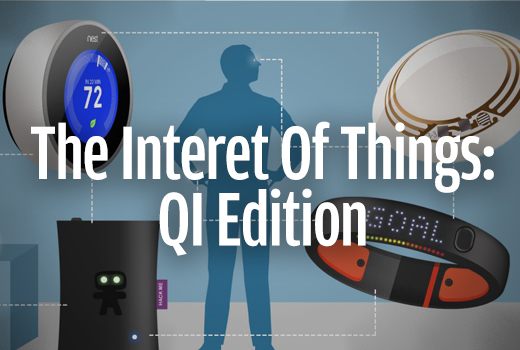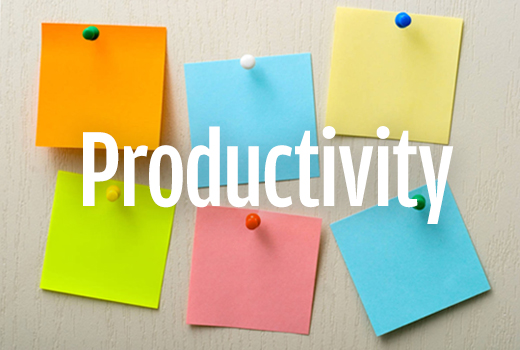June 13, 2014 - Comments Off on The MechCast 303: The Internet of Things
All Posts in The Thinking Mechanism
June 9, 2014 - Comments Off on The End of Web
The End of Web

By 1995, David Carson was the poster boy for an avant-garde and increasingly, subversive direction that graphic design was headed. He had built a global following of design school kiddies by bucking the traditional "ad-man" approach previously taken by Ogilvy, Burnett, Brownjohn and others with regard to clever, effective and readable advertising. Much like the controlled chaos of the Deconstructivists before them, in the cyclical karmic wheel of creative expression, Carson (and arguably Segura, Brody and others) had taken accepted graphic design in a direction that tore up the rules and started over. Their sauce was the gateway drug for Sagmeister and his ilk in later years.
I recall attending a HOW Conference in Monterey, California, where Milton Glaser, Bob Gill and their colleagues were publicly seething at Carson's new found popularity. These arguably brainer, and certainly more seasoned road dogs of the graphics industry, were, for the first time, being ignored by the graphic masses for a new, hot little surfer boy (who openly admitted he just fell into the industry like like a leaf into a big pond of ducks). There were lines around the block to have his new book, "The End of Print: The Grafik Design of David Carson", signed by the man himself.
For the ad-men, this was a moment of reckoning. At the Monterey HOW Design conference Bob Gill was more vicious and crabbier than usual. The unsuspecting rock stars of the past were now being exorcised by the new punk regime. The Sex Pistols were coming - and there was nothing that Jethro Tull and Yes could do about it. A creative tool called the computer, had replaced hand-cut rubylith and type.
Digital printing would slowly all-but-kill Gutenberg's printing press as a cheaper solution to your printing press expert, who was always there on press to get your colors just right. The industry of graphic design was becoming cheaper. We began to believe "shitty" was acceptable, and various economic factors and corporate budget cuts didn't help matters either. Software took away the human touch, tablets would later take away the notepad, and being digital began to slowly take root - a fungus to wash over the senior graphic Luddites, like a creeping red tide. An in-depth review of this historical moment in printing can be read on articles from https://www.littleprint.com.au, the review highlights key moments in the transition to digital. A clever and eye-opening read for millennials who have missed out on seeing the changes first hand.
A dear departed friend of mine once quipped, "What happens when everyone has a website?" Now that's a bit naive, but I get his point. While the convenience of smartphones and tablets has pushed us into a post-PC world, where expansive experiences are more desirable and useful than a website. Websites, by definition, are just a group of connected pages regarded as a single entity, and they are practically free if you look hard enough. The modern digital branded experience is much more.
Mobile devices and likely the upcoming wearable industry will continue to steadily infiltrate and replace the experience of a single website for an organization and brand's digital expression. In recent years, the concept of social media has raised the stakes by creating two-way conversations in real time with real expectations from your audience. We prefer to not be removed from experiencing one form of entertainment or educational media to sit down at a computer and look up a website. We want to experience all things collectively and collaboratively with our friends, and the distraction of a website, as we once knew it, is not nearly complex enough to satisfy our desires.
...Back to Carson and the End of Print. He later claimed that he wasn't trying to infer that the print industry was dead, but those who had just raised the flag of technology and the new coming internet revolution didn't care. His mostly unreadable style and grungy approach to design was necessary. It rocked the industry boat - and as music, fashion and entertainment fell into line - it forced the rules to change. The web would later become a viable and uniquely positioned means of both creative expression and a way for businesses to connect to consumers in sometimes profound ways - the world's most accessible art show and trade show under the same roof. The Nerds had their revenge while the ad-men were left to their martinis, suits and stories.
The Mechanism recently retired the word "website" from our vocabulary. It’s too close-minded and obvious a concept to exist as an agency without discussing the future of an integrated digitally-branded experience. In fact, we were 13 years ahead of our time when we started The Mechanism and used “From Media to the Medium” as our tagline. We believe that a website has always been a thread in the expanding tapestry of brand expression. We understood from the start that everything begins from the brand outwards, and given the technological tools that were available then (and are available now) the implementation of an idea in any Medium wouldn’t be the problem - it would be the enormous and interconnected creative collaborative that would be required to see through the changing variety of media delivery mechanisms.
The “website” as we all know is less important than what's coming next. Website development was the catalyst, a "blip" towards an interconnected omnipresent, ever-communicating "Singularity". We will soon live with systems that plug into an artificial or ambient intelligence to manage your life, curate your interests, drive a vehicle, keep track of your day to day travels and never force you to remove yourself from an existing experience to use a website to research what the Network will already know you’re looking for. The next generation will be the “Mighty Untethered”, ubiquitously connected to a Universal Machine. You and your friends and colleagues interests will be part of the system, and as they change, so will your personal experience to match your tastes. Diseases, dangers, economies and civilizations will be repaired on a global scale due to mass shared information and the artificial intelligence to be gained from it. Privacy will continue to suffer, but it has since the first time you signed up for a college loan.
Web developers, this is your moment of reckoning. When nearly everyone can make a peanut butter sandwich, it's not just time to suggest a banana - it's time to introduce it to the 10,000lb gorilla in the room.
Sitting on the couch, plugging-in and tuning out, growing fat, eventually growing tentacles and remembering what it once was like when we were knuckle-dragging Homo sapiens is a possible future. Or hopefully, our wearables, implants and attached digital devices will feature new, usable interfaces and non-intrusive experiences enabling us all to once again perceive the world around us with better clarity and understanding of the human experience.
The Web is dead, long live the Medium...
Published by: davefletcher in Entertainment, The Thinking Mechanism
Tags: bob gill, california, david carson, deconstructivist, how conference, milton glaser, monterey, ogilvy
May 28, 2014 - Comments Off on DANCING TO YOUR BRAND – How the Pet Shop Boys got me thinking about responsive design.
DANCING TO YOUR BRAND – How the Pet Shop Boys got me thinking about responsive design.
A few weeks ago, I took a trip back to the 90's by heading down to Terminal 5 for the Pet Shop Boys concert. The British electro-pop duo actually hit it big in the mid-1980's and have never stopped working, but I remember dancing all-out to their club sounds in the early 1990's.
This show was the last stop of their world tour and I had asked several friends to go with me… months in advance. Mood- pretty darn excited by my choice.
As the concert date drew closer, I wondered - will the Pet Shop Boys still feel relevant? Sure I think their music is great, but then I worried, will this be a memorable "experience" for all? or will it feel dated, quirky, and somewhat nostalgic.
Either way I thought this will reflect on me. I know we all worry when we are throwing down big bucks for a concert and coercing friends to go. YOU become the host and you are somehow responsible for everyone enjoying the event. Your mouth is saying "come on... it will be great!", while your brain is whispering - "it had better be since you bought 8-pricey tickets to this shin-dig"!.
Well I have to say the show was amazing. Neil Tennant, and Chris Lowe are still a perfect blend of electro-pop craftsmanship and really interesting performance art. A funky spacious club in New York City was the perfect venue to share the experience. And we really did "share" the experience. All around me people were holding up their Smartphones (which was not broken like mine) - taking pics, recording video (see photo above - I took that one at the show) - and thank goodness, since half the time I couldn't see the stage - I could however see it on the phone of the tall person in front of me - revelers were Tweeting, Tumbling, Pinning and sharing the experience in real time.
Which got me to thinking ...
Not that long ago people went to concerts and went nutty. We danced, sang, and sweated and told our friends about it the next day. "You should have seen Blink-182 last night man, it was insane!" (I went mid-2000's here to illustrate my point...remember the first release of the iPhone was June 2007 - and all of the realtime sharing came in the following years).
So my thought. Technology moves faster than a one-hit-wonder drops in the charts.
Right now, We are a culture in motion.
Everyone participates in the moment equally in realtime. Snaps and videos of your experience are up online before you leave the parking lot.
My question to friends, clients, and potential clients is this.... are people dancing to your brand? Or is your website a Wallflower? (Yes I know another great band from the past).
Internet browsing from smartphones and tablets grew 35% from Q4 2012 to Q4 2013. Simply put - Almost a third of global Internet traffic to North American web sites—31.3%—in the fourth quarter of 2013, came from smartphones and tablets, according to marketing and public relations firm Walker Sands Communications’.
According to Mill and Brown Research, per day Americans spend -147 minutes on mobile phones, 113 minutes viewing television, and only 108 minutes on their PC. easy to see who is winning the race here. We use a lot of mobile apps all the time. This can be a great tool to develop your business. Learn more at Sandcastle-Web.com and get the most from your mobile app.
Now ask yourself - How does your company's website hold up when you hold your phone up? How are people accessing your website? Is it a satisfying user experience?
In the same way I thought about my friends judging me based on a concert experience… I wonder, how are your clients judging your brand based on the mobile experience your website provides? Does your site feel relevant? Is it satisfying and engaging? Is your mobile web experience worth sharing and talking about? Or does it feel dated, quirky, and somewhat nostalgic?
The Mechanism has been a pioneer of Responsive Design from its earliest days.
Check out our own site right now on your smartphone or tablet.
Functional design and a pleasing user interface, these are the things that excite me as a designer, creator and a user.
Note how our site reconfigures gracefully to maintain large action buttons, and behold - text that remains readable. Fluid grids and flexible images are the cornerstone to a satisfying user experience. Other benefits include interactive calls to action such as one-tap to dial a phone number within your site, one-tap to email or interact with your site.
Just imagine... all you Non-Profit organizations out there, this could mean the difference between an immediate digital donation or a delayed action that is never acted upon.
The opportunity for your clients to take immediate action is in the palm of their hands.
I could go on however, I would rather invite you to join in a conversation.
The Mechanism's first of this seasons in-house conversations on best practices for your digital brand experience will kick off on Friday, June 13th, at 8:30 am at our place.
We will be featuring an intimate chat with our Founder and Executive Director Dave Fletcher about True Responsive Design and your brand experience.
We have limited seating and coffee. If you would like to join us please register by clicking here!
Can't attend? Just contact me directly to chat - 212-221-3444 x-102
Best,
Michael
Published by: michaelanthony in Non-Profits, The Internal Mechanism, The Thinking Mechanism
Tags: chris lowe, pet shop boys, responsive design
May 9, 2014 - Comments Off on The MechCast 302: Internet Privacy
The MechCast 302: Internet Privacy
On this episode of The MechCast, Michael (our host), Tope, Dhruv, George, Dave, & Joe discuss privacy on the internet, how safe we really are while surfing the web, and how we as individuals feel about our own digital footprint.
Related Links:
- Call for Limits on Web Data of Customers
- How To Remove Yourself From The Internet"
- Lightbeam for Firefox"
- Collusion for Chrome
- How Does Invisible Pixel Conversion Tracking Work?
Music:
Published by: antonioortiz in The Mechcast
Tags: data, podcast, privacy, tracking
May 2, 2014 - Comments Off on Never Hear Them Coming
Never Hear Them Coming
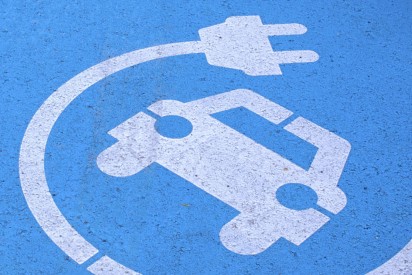
Small wins.
The Danish Energy Agency allocated EUR 4 million for public and private electric car projects. This will bring 1500 new electric cars to the streets of Denmark in 2014. With about 6 million people, they are approximately 1.5% the population of the US.
Bhutan, the Himalayan kingdom of 700,000 people, measures progress by the gross national happiness index. They also export 72% of their electricity. Nissan is helping them to build a complex infrastructure for charging their whisper-quiet Leaf electric and diesel cars you can easily repair with parts from local diesel engine core buyers when need.
Electric cars are so smooth, nimble and silent – you don't even hear them coming.
In the United States, we have oil lobbyists fighting against the existence of electric cars to their last breath, all part of our historically vaudevillian political system where money and power are sadly trumping progress. Getting these jackals to finally back off enough to even allow rational conversations about electric cars will require such a widespread public demonization of oil, that cowboys will have to kneel before the masses and swear that Texas tea is really made from fresh butterfly milk.
Remember, the United States (and arguably Canada and South Africa) has Elon Musk, the baddest-ass electric car maker in the world, headquartered right in Palo Alto. A ruthless innovator, rocket launcher and inventor like this hasn't been seen since "The Great and Powerful Jobs". And what do the bureaucrats do to Musk through lobbyists and political baboonery? They tar, feather and shit on him. He'll eventually take his magic ball and teleport to another playground. But, we're too busy punching the nerd in the face to notice that we're actually slugging an invincible warlock.
And such is our system. Obese and overwrought with so much rotten sausage that if we keep it up, we are likely to fall behind even the developing world in a generation or two. By the time we pluck our heads out of our own posteriors and realize that politics ain't reality tv, it'll be too late.
Charging equipment for PEVs is classified by the rate at which the batteries are charged. Charging times vary based on how depleted the battery is, how much energy it holds, the type of battery, and the type of charging equipment (e.g., charging level and power output). The charging time can range from less than 20 minutes to 20 hours or more, depending on these factors. Charging the growing number of PEVs in use requires a robust network of stations for both consumers and fleets. Learn more about ecologic infrastructure from Sinisi Solutions.
To get electricity you have to start with an alpha particle.
You want electric cars? You might have to travel to tiny Norway. In March 2014, Norway became the first country where over one in every 100 registered passenger cars is plug-in electric. Among the existing government incentives, all-electric cars are exempt in Norway from all non-recurring vehicle fees (including purchase taxes - which are extremely high for ordinary cars), and 25% VAT on purchase, together making a whisper-quiet electric car purchase price competitive with conventional cars. Take that oil lobbyists...
You want your government out of net neutrality? You might have to go to smart, little Brazil for internet freedom. Remember, when you disrupt the flow of free ideas by allowing money to clog the pipes, you'll have such a backlog of slime that you'll need to hire Godzilla the plumber to clean them out. And as we all know, Godzilla makes a big mess.
when you disrupt the flow of free ideas by allowing money to clog the pipes, you'll have such a backlog of slime that you'll need to hire Godzilla the plumber to clean them out.
It's also why a small agency wins. Small is nimble. Nimble is smart. Smart is quick. And assuming the person at the top of a small agency is open minded and searching for a future not caught in the past, then the possibilities are endless.
Made in NYC? Yea, I've heard of it - The Mechanism helped to write that book for the past 13 years. We're nimble, speed-hungry, cockroaches, nestled in the bowels of New York City. We're surviving, and we're whisper-quiet.
And you know what? You never hear us coming either.
Published by: davefletcher in Government, The Thinking Mechanism
Tags: bhutan, denmark, made in nyc, net neutrality, nissan leaf
April 29, 2014 - Comments Off on The MechCast 301: How Do You Define Productive?
The MechCast 301: How Do You Define Productive?
After a long deadline-mandated hiatus The MechCast returns with a promised discussion on productivity. We begin by introducing new members of our growing team and then get into a passionate discussion on how we each define being productive and in turn productivity. We then talk about the tools and inspirations of our productivity.
Related Links:
- John Cleese On Creativity
- Gerhard Richter "The Daily Practice of Painting"
- David Allen "Getting Things Done"
- Mailbox
- Skype
- Merlin Mann Inbox Zero
- Spotify
- Post-it Notes
Music:
Published by: antonioortiz in The Mechcast
Tags: discussion, podcast, productivity
April 17, 2014 - Comments Off on How to Put a Mustang on Top of the Empire State Building
How to Put a Mustang on Top of the Empire State Building
Thursday is the Mustang’s 50th anniversary. To mark the occasion, Ford plopped a 2015 Mustang GT convertible onto the observation deck of the Empire State Building.
Ford pulled the same stunt with the original classic Mustang, but five decades of technological advancements haven’t made it any easier to pull off. The deck is 1,000 feet up, so using a crane is out of the question. And the building’s tall spire rules out lowering the car from a helicopter.
That leaves the freight elevator. So, just as they did in 1965, Ford had the automotive wizards at DST Industries chop a Mustang into six pieces for the ride to the 86th floor, where the car was reassembled in the wee hours today.
At the time of its construction, there was fierce competition to win the title of tallest building in the world. The Chrysler Building claimed the title in 1929, and the Empire State Building seized it in 1931, its height being 1,250 feet (381 metres) courtesy of its iconic spire, which was originally intended to serve as a mooring station for airships. A 222-foot (68-metre) antenna was added in 1950, increasing the building’s total height to 1,472 feet (449 metres), but the height was reduced to 1,454 feet (443 metres) in 1985 when the antenna was replaced. (By that time One World Trade Center, officially opened in 1972, had become the tallest building in the world.)
Construction began 200 days later on March 17, 1930. Between the time that Smith made the announcement in August and construction began in March, however, the stock market crashed, in October of 1929, and the Great Depression began to take hold. Nevertheless, construction continued and proved an important source of jobs in New York City. The Empire State Building formally opened on May 1, 1931. Construction of the immense skyscraper took less time than anyone could have anticipated, concluding after only 410 days after they placed the laminate flooring. Despite the publicity surrounding the Empire State Building, its opening was still heavily affected by the coinciding Great Depression; much of the office space remained unrented, to such an extent that the building was called “The Empty State Building.” It took almost 20 years for the building to become profitable.
Wired has a fantastic blog post with images and video of how this was accomplished.
Published by: antonioortiz in The Thinking Mechanism
Tags: empire state building, ford, mustang
March 21, 2014 - Comments Off on Marketing the Meme
Marketing the Meme
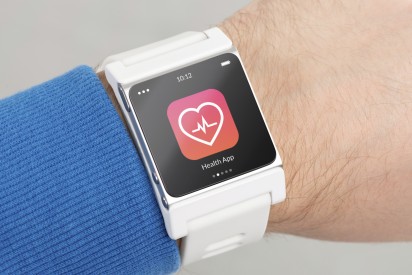
If you blinked, you may have missed that for the moment, it's all about health-related wearables. Generation X not only wants to, but firmly believes that we can live forever. Ask Ray Kurzweil, an elder statesman of futurism and author of The Age of Spiritual Machines, and The Singularity is Near, with the help of our machine overlords and a nice regimen of pills, we'll soon be downloading our brain into the Universal Mind. Health wearables, in their current state, are the perfect snake oil to market to a generation hell-bent on avoiding purgatory. It's Terminator X. And it's not a matter of if, but when.
Data is King - the device is just the royal messenger.
If you asked me two minutes ago, I would have said that one way Apple could save itself from inevitable obscurity (high-noon is coming for Apple under the marketing machine of every other tech company that wants to destroy them for the simple reason that Steve Jobs existed and pissed them all off) was not even to bother releasing a digital watch. They needed something "bigger," but still in the spirit of a wearable. A watch or wearable for checking email, or knowing that your mate is drunk texting you at 2am (in my opinion) was already existing quite comfortably in the realm of Samsung and a dozen other crowdsourced devices. However after I find this condition disturbing, the doctor gave me a discrete and clever device that is plugged into the cloud by transmitting my health information and data in real time to be compared against the rest of the planet - well there's something that I can get behind. All these information and data can be effectively managed with the help of access request management services by TOOLS4EVER. Smart, predictive medicine and fitness - imagine how much that would help our race to fill up the overcrowded planet even quicker, if you are trying to lose overweight try out leptoconnect.
Wearables DevCon is happening in San Francisco in March, so it seems that all Apple needs to do is fart an idea into the wind (Note: I'm not insinuating that Apple invented the wearable industry, it's just that Apple has been teasing the idea of a watch for so long that they've become the boy that cried werewolf), and the world's innovators now proceed to leapfrog them rather than wait to build on their platforms. It makes for a real mess when it comes to products. Too much competition eventually becomes unregulated noise, and too many unregulated products rushing to market will kill the market before it has a chance to blossom.
I discovered this on a recent trip to Best Buy. I was there to observe a business model rolling under itself - a library of tech that is filled with browsers but very few buyers. It turns out that Best Buy has an entire aisle dedicated to health wearables - each device more specialized and useless than the next. Nothing on the shelf fully grasps the concept of a health ecosystem, because they are the shoddy output of mindless corporate meetings called to simply "Market to the Meme." Learn more about resurge.
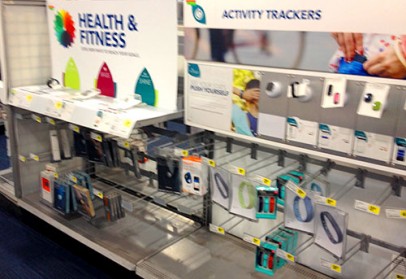
If Apple gets the health wearable right, they could dominate, but the domination will come from the thoughtful integration of the device into iCloud. Google had a health cloud product (Google Health) many years ago, but unexpectedly shut it down due to a shift in the wind, like many of their other products. Think of how ahead of the game they could have been with the release of Android Wear. Right now, some executive who made that decision is hiding under their hydroponic desk chamber - because they could have been light years ahead of Apple. With Healthcare like every other industry, Data is King - the device is just the royal messenger. When looking to improve our health and raise the bar of your health app goals, check here for the best test booster.
So a successful launch of iWatch (don't get me started about how perfect that name is for a device which keeps an "eye on your health and well-being") would require the following:
- Data infrastructure - The means to record personal Health data safely and securely. iCloud is already in place for that.
- Automatic sync - A device which reports automatically to the cloud - we're all too lazy to sync our devices. Ask Nike how many people sync their Fuelband a month after putting it on.
- Price - The price point has to be fair for this as well, because the more people using it the better. It should be released as a discrete necessity, with the basics included like heart monitoring, steps taken per day, and calories burned.
- Open source development - A means to use the data and present info graphics and tools for individuals. Apple got it right with iOS and the App Store. Not everyone will be a runner, but a running app, a weightlifting app tracking reps, weight lifted, a pill taking app that reminds you when to take them, etc. -- all will be part of the health ecosystem with the right developers making money for their hard work.
Due to their formidable marketing prowess, the first loud shot has been fired by Apple in the healthcare and fitness revolution with the announcement of Healthbook. The only question is how thoughtful, nimble and careful they can be anymore when the snarling wolves are at the back door of their spaceship -- and they're all wearing Samsung watches on their paws... Integrated neatly into their own proprietary healthcare ecosystem.
Published by: davefletcher in Pharmaceuticals, The Thinking Mechanism
Tags: best buy, data, healthcare, ray kurzweil, san francisco, wearables, wearables devcon
March 18, 2014 - Comments Off on Bill Gates: The Rolling Stone Interview
Bill Gates: The Rolling Stone Interview
When you started Microsoft, you had a crazy-sounding idea that someday there would be a computer on every desktop. Now, as you return to Microsoft 40 years later, we have computers not just on our desktops, but in our pockets – and everywhere else. What is the biggest surprise to you in the way this has all played out?
Well, its pretty amazing to go from a world where computers were unheard of and very complex to where theyre a tool of everyday life. That was the dream that I wanted to make come true, and in a large part its unfolded as Id expected. You can argue about advertising business models or which networking protocol would catch on or which screen sizes would be used for which things. There are less robots now than I would have guessed. Vision and speech have come a little later than I had guessed. But these are things that will probably emerge within five years, and certainly within 10 years.
via Bill Gates: The Rolling Stone Interview | Rolling Stone.
That's how the must-read interview begins.
Published by: antonioortiz in The Thinking Mechanism
Tags: bill gates, microsoft
March 17, 2014 - Comments Off on U.S. to Give Up Key Internet Governance Role
U.S. to Give Up Key Internet Governance Role
Obama administration officials moved late Friday to end the U.S.’s role in overseeing Internet domain names and addresses, announcing plans to relinquish its role by the end of next year and turning the keys over to the global Internet community.
Commerce department officials announced that the U.S. government would relinquish its role overseeing Internet addresses in favor of a to-be-determined global body.
The Internet Corporation for Assigned Names and Numbers has managed the use and governance of domain names and Internet addresses for the U.S. government since 1998, when it was awarded the task by the Commerce Department. Based in Los Angeles, ICANN oversees the Internet’s address system and has moved in recent years to open up new domain names.
via U.S. to Give Up Key Internet Governance Role | Re/code.
Pair this announcement with An online Magna Carta: Berners-Lee calls for bill of rights for web.
Published by: antonioortiz in Government, The Thinking Mechanism
Tags: barack obama, U.S. Government
